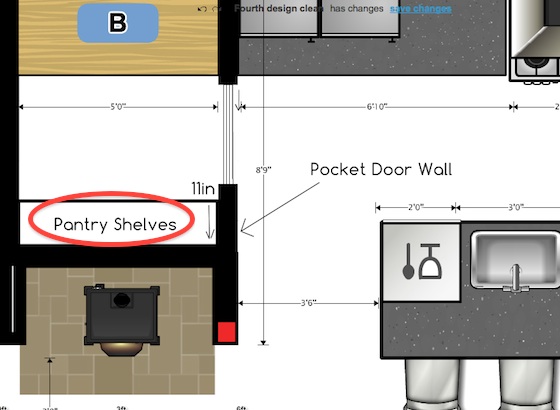How to Attach Shelves to a Pocket Door Wall
Quick Column Summary:
- How to attach shelving on pocket door wall
- Glue and nail cleats for support
- Use construction adhesive for the best support
DEAR TIM: We have a pocket door to our pantry in our kitchen. We plan to install 10-inch-deep wood shelving perpendicular to the pocket door wall. This means we need to be careful when anchoring the sides of the shelves. I attached a diagram so you can see what I mean. What is the best way to anchor the shelving to a pocket door wall? Are there any shallow drywall anchor solutions that would work for this scenario? What other options do I have? What would you avoid? Rae J., Burlington, VT
DEAR RAE: First I want to congratulate you or the architect for selecting a pocket door for your pantry. I’m a huge fan of pocket doors because of the amount of space they save. The last thing you want is a door swinging into a narrow pantry where space is at a premium. Or in your case, the door swinging into the kitchen blocks the pathway between the pantry and the island.
The house I live in now, and I didn’t build it, has a swinging door into our master bedroom closet. This door makes it impossible to access my clothes unless I enter the closet and close the door! A person suffering from claustrophobia would freak out with the door closed. Sadly, a space-saving pocket door could have been installed with no effort. I had a pocket door for our master bedroom closet in the last house I built and lived in.
The good news is you can successfully secure the shelves to this pocket door wall. Even though the pocket cavity limits the space for fasteners, you’ll not create a situation where the sliding door will get scratched by a nail or screw poking through the wall.
If you were building a new home and you knew you might be installing shelves or hanging heavy pictures on a pocket door wall, I’d recommend you do a trick I did for years. I’m sure I’m not the first builder to do this, but I always glued and screwed pieces of 1/2-inch plywood to the back of the drywall that covered the thin studs that create the pocket for the door. The pieces of plywood fit in between the pocket door wall studs.
This plywood could be applied to the one side of the pocket after the drywall was installed because you could access the inside of the pocket easily. The other side of the pocket required the plywood pieces to be attached to the drywall before it was screwed to the pocket door wall studs. It only took a few minutes of extra time to do this. Since the pocket door wall studs were normally 3/4-inch deep, the 1/2-inch plywood never had a chance of touching the moving door.
Since you can’t add this plywood, I’m going to recommend you glue and nail the cleats that support the shelves. Pantry shelves need to be strong because you, or a future homeowner, may fill the shelves with cans or jars that are very heavy.
The key is to make sure the cleats that support each shelf are at least 1 and 1/2-inches wide and support the shelf on at least three sides. Using wider cleats like this helps to spread out the weight because you have more surface area of the cleat contacting the wall surface.
Use construction adhesive sold in caulking tubes. The consistency of this glue is perfect for this task as it will not run down the walls like a thin wood glue in a bottle.
I would recommend using 2-inch-long finish nails driven at a 45-degree angle to secure the wood cleats to the drywall. I would alternate aiming the nails left and then right spacing them about 6 inches apart. Nailing them at the 45-degree angle ensures that the nail will penetrate the backside of the drywall by about 1/4 of an inch.
The purpose of the nails is to hold the cleat in place as the construction adhesive cures. The nails will support quite a bit of weight on their own, but the adhesive will do the lion’s share of the work when it comes to supporting the shelf weight.
I would avoid using wire shelving that typically has only one support point at the sides of shelving. This single bracket concentrates the weight to just one small spot. What’s more, you usually have to use expanding anchors that might interfere with the sliding door.
Don’t fall into the trap of using a shelf cleat on just the ends of the shelf. Many people do this to save time, but in your case you need the shelf cleat that runs along the entire back of the shelf. This rear cleat will help distribute much of the weight along the back wall. Be sure this cleat is fastened into the regular wall studs on this wall.
Don’t load the shelves with weight for at least 48 hours. This will give plenty of time for the construction adhesive to cure. If the room temperature is less than 50 F, I’d wait at least 72 hours.
Column 1023

15 Responses to How to Attach Shelves to a Pocket Door Wall